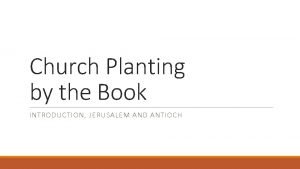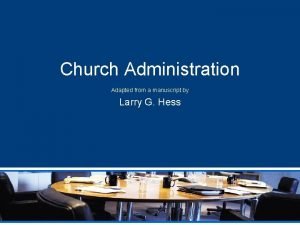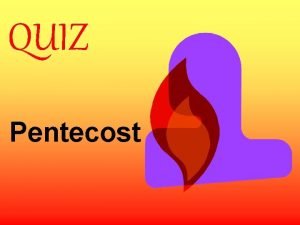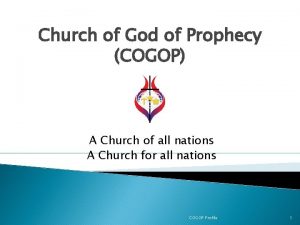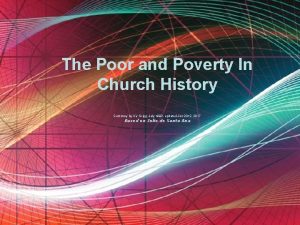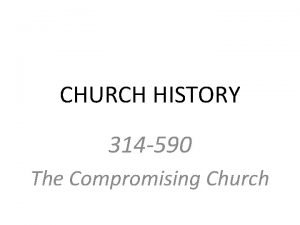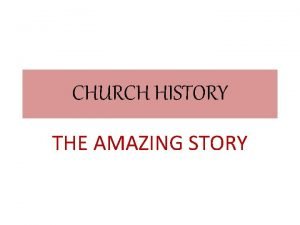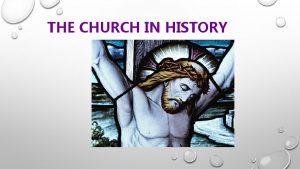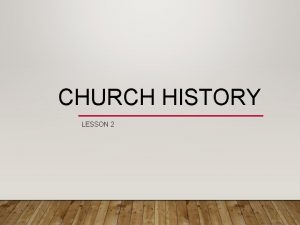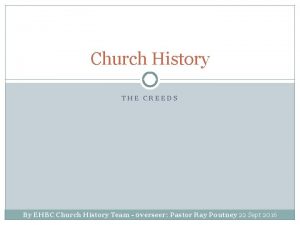Church History Overview Class 1 Introduction and History














- Slides: 14

Church History Overview: Class 1: Introduction and History to Constantine the Great Ann T. Orlando IAP 2005

Introduction • Purpose: Provide a basic introduction to Catholic Church History in 4 one-hour lectures • Church periods for this class: – Wk 1: Beginning to Constantine the Great (“in the beginning” to 312) – Wk 2: Constantine to Charlemagne (312 to 900) – Wk 3: Medieval Europe (900 to 1500) – Wk 4: Reformation and JPII (1500 to 2000) • NB: I am teaching a semester long class in Church History at St. John Seminary. Feel free to go to my website for this class at http: //web. mit. edu/aorlando/www/Church. History/

Overview of Week 1 Lecture • Background to the beginning of Church history in three strands – Story of people Israel (Old Testament) – Secular history – Philosophical history • New Testament as historical document; missionary activities; first council • Second Century – – Complete break with Judaism What is canon of Scripture Relations with Empire Who has authority in Church • Third Century – Imperial Chaos and Empire-wide martyrdoms – Impact of neo-Platonism – Development of Christianity in North Africa

“In the beginning… • • • The Bible tells theological story of the Church and God’s revelation to the Church Adam, Eve, the Fall and God establishes a people with a special relationship to Him: dateless, timeless; Genesis Moses c. 1250 BCE (BC) Exodus through Deuteronomy David c. 1000 BCE Samuel, Kings, Chronicles Destruction of 1 st Temple; 586 Babylonian Captivity by Nebuchadnezzar; Isaiah, Jeremiah, Ezekiel, Return and rebuilding of Temple (Second Temple) 539 BCE by Persian King Cyrus; Ezra, Nehemiah Israel between two great Greek powers; 330 BCE to 160 BCE; Maccabees appeal to Rome for help; Daniel writes about whore of Babylon, but really is referring to Seleucids Palestine a client of Rome 160 BCE to 4 BCE (death of Herod the Great) Jesus Christ 1 to 33 CE (AD) Palestine revolts; destruction of Second Temple in 70 CE; occupied by Rome until 600 CE and Moslem conquests New Testament written 50 and 90 CE Rome as whore of Babylon in Revelation

Secular History Background • Alexander the Great – – • Hellenistic (Greek) Empires 323 – 31 BCE – – • • Son of Philip of Macedonia; Student of Aristotle Conquers the ‘world’ by age of 33 Founds Alexandria, center of learning for next 600 years Dies in 323 BC; leaving his generals in charge of various parts of his conquests Macedonians: Greece, Sicily, southern Italy Seleucids: Asia Minor, Syria and Mesopotamia Ptolemies: Egypt and Cyrene As a result of this extended period of Greek rule, the ‘lingua franca’ of the Mediterranean was Greek from the 4 th C BC until the 5 th C AD in the West and the 15 th C in the East Israel between two major competing Empires: Seleucid and Ptolemy Rome – – – – Traditional founding date of 753 BCE Started as a Republic ruled by Senate Punic Wars, conquers and destroys Carthage 202 BCE Maccabees ask Rome for help against Seleucids 160 BCE Julius Caesar conquers Gaul 80 BCE Augustus defeats Anthony and Cleopatra (last Ptolemy ruler of Egypt) at Actium in 31 BCE; Roman Empire established Roman Empire existed in some form between 31 BC and 1453 AD

Philosophical (Greek) Background • Athenian Philosophy Before Alexander – Socrates and Plato: Platonism (and indirectly skepticism); Academy – Aristotle: Plato’s student, founder of Lyceum and Aristotelianism • Hellenistic Philosophy – Epicurus, fought in Alexander’s army; opposed to Plato, founder of Epicureanism; the Garden – Zeno: opposed to Epicurus, founder of Stoicism; the Stoa • Neo-Platonism centered in Alexandria 250 CE • Catholic Christianity has always used contemporary philosophical methods as the language of theology and as an aid to interpret the Bible; philosophy as the handmaid of theology. Example: Virtue

Roman Society • • Do not judge ancients by modern standards Roman religion was a public, civic obligation; – NOT a way to have a personal relationship with Divine – ‘mystery religions’ became very popular in 1 st through 3 rd Century Roman Society (Cults of Mithra; Isis and Osiris; Dionysius) – Anyone who did not offer sacrifice for the good of the state was considered an atheist • • Roman Emperor increasingly was a soldier who was ‘adopted’ by current Emperor (Augustus). Cult of Roman Emperor as god in his lifetime was started by Nero Roman household was composed of patron (father) and clients (wife, children, slaves, business associates dependent upon him) – Father had complete control of clients – Adoption was very common – Owning property was far more prestigious than commerce • • Excellent road and mail system throughout the Empire Note that the most Latin (least Greek) part of the Empire was North Africa

History of Church in New Testament • Paul’s Letters are the oldest Christian documents we have. However, Paul was not writing a general history, he was responding to specific problems in specific communities (except for Romans) • [Paul and Peter martyred in 64 AD by Nero] • Gospel of Luke and Acts of Apostles – written in an ancient historical style; Luke gives an ‘ordered account’ of Jesus and the early Church – Council of Jerusalem in which Paul’s position that Gentiles do not need to convert to Judaism is affirmed (Acts 15) – Story of how the Church was spread by Paul’s missionary activity • Revelation (most scholars believe) is based on persecution of Christians in Asia Minor during Domitian’s reign; Rome as whore of Babylon • Note: John’s Gospel is most philosophical; Jesus as Logos

What Happened to Judaism in this Period • Before and during Jesus’ life there were many types of Judaism – Pharisees: upholders of the Law (Torah) – Sadducees: from aristocracy and high priests, did not believe in resurrection of dead; closely associated with Temple – Essenes: disgusted with impurities in Temple; left for desert – Zealots: ‘terrorists’ against Roman occupation – Diaspora Jews not living in Palestine but scattered around Mediterranean; Greek Jews (Hellenists in Acts of Apostles) – Jews in Mesopotamia who did not return after the exile in 6 th C BC • • During the First War with Rome 66 -73 AD, the Sadducees, Essenes and Zealots were destroyed In 117 AD the Emperor Trajan destroyed the Hellenistic Jewish community in Alexandria; after this the Greek Jews seemingly either converted to Christianity or rabbinic Judaism The Pharisees were the group out of which rabbinic Judaism grew in the 2 cd and 3 rd C CE. They reestablished contact with the Mesopotamian Jews and their theology; rejected use of Greek philosophy and parts of the OT written in Greek, not Hebrew Hellenistic Jewish theology was taken over, preserved and used by early Christian theologians, especially in Alexandria

Second Century Christianity Key Issues • What constitutes Scripture? – Multiple gospels (some rather bazaar) were used by Gnostics – Status of OT; some (Marcian) wanted to reject all of OT and most of NT • What is role of philosophy is Christianity? – How to interpret the Scriptures – Philosophical understanding of Trinity • Relationship with Empire – How to deal with sporadic (but very real) persecutions – Can a Christian also be a good citizen? • Internal Church authority – Who decides and teaches what is orthodox

Second Century Issues ‘Resolution’ • Scripture: – Based upon the Greek OT the Septuagint which includes the deutero- canonical works; and the 27 Books of the NT; – St. Irenaeus, Bishop of Lyons, was among the first to reject other books of Scripture and to support these • Philosophy: – – • Early Orthodox theologians used Stoicism Multiple levels of meaning of Scripture; Jesus, although God, had a real body that suffered Justin Martyr developed the idea of Jesus as Logos Relation to Empire – Christians tried to be good citizens and encouraged praying for welfare of Emperor – Christians tried to explain themselves to intellectuals of their day in apologies (Justin Martyr, Tertullian) – Viewed with suspicion by pagan neighbors because they were a ‘new’ religion (superstition); period of sporadic persecution • Authority in Church – – ‘What the Church prays the Church believes’ Development of structure of bishops assisted by deacons and presbyters (elders) St. Ignatius of Antioch, martyred. c 110 in Rome Apostolic succession of bishops (but NOT special secret knowledge)

Third Century Issues • Empire-wide Persecutions – Instability in third century empire led to increased persecutions – Waves of persecutions led some to apostasy then want to return to the Church – How best to remember the martyrs • Development of liturgy – Organized, standardized prayers for Eucharist – Organized approach to catechumens • How to include new philosophical methods

Third Century ‘Resolutions’ • Donatist Controversy – Donatist, especially strong in North Africa, did not allow those who had apostatized to return to Church; the Church of the ‘pure’; Ministers had to be especially pure – Orthodox church allowed lay and ministers to return to church with appropriate public penance • • Beginning of hermits in desert who wanted to escape civilization to lead a pure life Certainly Eucharist before third Century (Paul’s Letters, Gospels, Didache) but specific practice developed in third century; St. Hippolytus – Rites for ordination of bishops – Rites for instruction of catechumens and baptism at Easter Vigil • New philosophical developments: neo-Platonism – Origen and how to think about Jesus and Trinity – Augustine and how to think about evil – Guided Christian theological developments until 13 th C in West

What’s Next Week? • Constantine the Great – The Christianity goes from being persecuted to being the official religion of the Empire – Model for Church-State relations for next 1000 years • Defining beliefs more carefully – Councils of Nicea, Ephesus and Chalcedon – Great theologians East and West • Fall of Rome (in the West) • The Church as the social and educational backbone of Europe • Rise of Islam • Charlemagne • Breakup of Charlemagne’s Empire
 Multicullar
Multicullar Papercut job ticketing
Papercut job ticketing Introduction product overview
Introduction product overview Introduction product overview
Introduction product overview Introduction product overview
Introduction product overview Introduction to church planting
Introduction to church planting Introduction to church administration
Introduction to church administration Difference between abstract class and concrete class
Difference between abstract class and concrete class Difference between abstract class and concrete class
Difference between abstract class and concrete class Therapeutic class and pharmacologic class
Therapeutic class and pharmacologic class Static vs dynamic class loading
Static vs dynamic class loading Pentecost quiz
Pentecost quiz Logo cogop
Logo cogop History of the church summary
History of the church summary Virusmax
Virusmax





